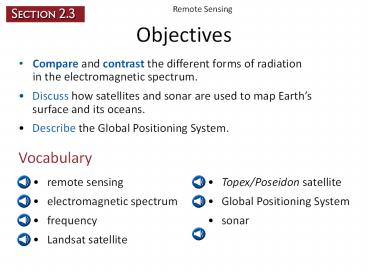Objectives - PowerPoint PPT Presentation
1 / 11
Title:
Objectives
Description:
Remote Sensing Objectives Compare and contrast the different forms of radiation in the electromagnetic spectrum. Discuss how satellites and sonar are used to map ... – PowerPoint PPT presentation
Number of Views:64
Avg rating:3.0/5.0
Title: Objectives
1
Objectives
Remote Sensing
- Compare and contrast the different forms of
radiation in the electromagnetic spectrum.
- Discuss how satellites and sonar are used to map
Earths surface and its oceans. - Describe the Global Positioning System.
Vocabulary
- remote sensing
- electromagnetic spectrum
- frequency
- Landsat satellite
- Topex/Poseidon satellite
- Global Positioning System
- sonar
2
Remote Sensing
Remote Sensing
- Until recently, mapmakers had to go on-site to
collect the data needed to make maps.
- Today, advanced technology has changed the way
maps are made. - Remote sensing is the process of collecting data
about Earth from far above Earths surface.
3
The Electromagnetic Spectrum
Remote Sensing
- Satellites detect different wavelengths of energy
reflected or emitted from Earths surface.
- This energy has both electric and magnetic
properties and is referred to as electromagnetic
radiation. - Electromagnetic radiation includes visible light,
gamma rays, X rays, ultraviolet waves, infrared
waves, radio waves, and microwaves. - Ralphs Mother Is Visiting Uncle Xaviers Garden
- From lowest frequency (high wavelength) to high
frequency (low wavelength)
4
The Electromagnetic Spectrum
Remote Sensing
- Wave Characteristics
- All electromagnetic waves travel at the speed of
300 000 km/s in a vacuum, a value commonly
referred to as the speed of light. - Electromagnetic waves have distinct wavelengths
and frequencies. - The electromagnetic spectrum is the arrangement
of electromagnetic radiation according to
wavelengths.
- Frequency is the number of waves that pass a
particular point each second.
- These unique characteristics help determine how
the energy is used by different satellites to map
Earth.
5
The Electromagnetic Spectrum
Remote Sensing
- Wave Characteristics
6
Landsat Satellites
Remote Sensing
- A Landsat satellite receives reflected
wavelengths of energy emitted by Earths surface,
including some wavelengths of visible light and
infrared radiation.
- Since the features on Earths surface radiate
warmth at slightly different frequencies, they
show up as different colors in images
7
Topex/Poseidon Satellite
Remote Sensing
- The Topex/Poseidon satellite uses radar to map
features on the ocean floor.
- Radar uses high-frequency signals that are
transmitted from the satellite to the surface of
the ocean.
- A receiving device then picks up the returning
echo as it is reflected off the water.
8
Topex/Poseidon Satellite
Remote Sensing
- The distance to the waters surface is
calculated using the known speed of light and
the time it takes for the signal to be reflected.
- Variations in time indicate the presence of
certain features on the ocean floor.
9
The Global Positioning System
Remote Sensing
- The Global Positioning System, or GPS, is a
radio-navigation system of at least 24 satellites
that allows its users to determine their exact
position on Earth.
- Each satellite orbits Earth and transmits
high-frequency microwaves that contain
information about the satellites position and
the time of transmission. - A GPS receiver calculates the users precise
latitude and longitude by processing the signals
emitted by multiple satellites.
10
Sea Beam
Remote Sensing
- Sea Beam technology is similar to the Topex/
Poseidon satellite in that it is used to map the
ocean floor.
- Sea Beam is located on a ship and relies on sonar
to map ocean-floor features. - Sonar is the use of sound waves to detect and
measure objects underwater.
11
Sea Beam
Remote Sensing
- First, a sound wave is sent from a ship toward
the ocean floor.
- A receiving device then picks up the returning
echo when it bounces off the seafloor.
- Computers on the ship can then calculate the
distance to the ocean bottom based on the time it
takes the signal to be reflected.































